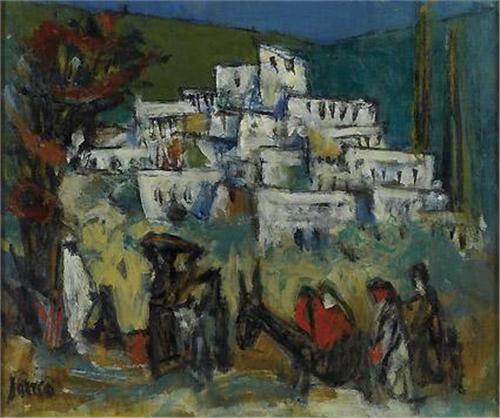
April 21, 1984
Marcel Janco, one of the founders of the Dada Art Movement passes away at the Sheba Medical Center in Tel Hashomer at the age of 88. Janco is born in Bucharest, Romania in 1895 and becomes active in the Bucharest art and literary scene at a young age, studying painting and drawing with Iosif Iser, a fellow Romanian Jewish painter and graphic artist.
In 1914, he departs Bucharest and goes to Zurich to study math and chemistry at the Polytechnical Institute. A year later, he decides instead to study architecture under the renowned Swiss architect Karl Moser. In Zurich, Janco comes into contact with a number of other painters and authors, including his childhood friend Tristan Tzara, a poet and performance artist with whom he had founded a literary and art journal, Simbolul in Bucharest in 1912.
The group of artists with whom Janco associates in Zurich are almost all exiled foreigners residing in the city as a result of World War I. They share an opposition to the war and social, political and cultural values of the time. In February 1916, the group founds the The Cabaret Voltaire, a Zurich club and bar which seeks to be “a center for artistic entertainment…. run by artists, permanent guests, who, following their daily reunions, will give musical or literary performances.” (Hugo Ball, La fuite hors du temps ([1946], 1993) p.111, cited at http://www.dada-companion.com/cabaret/, accessed March, 2016.)
Janco is in charge of designing scenery and building sets for the numerous performances that take place at Cafe Voltaire, and his most notable work in this period are the masks he creates. The movement, which these artists found is called Dada; the term supposedly chosen for its abstract sound and its resemblance to baby talk. Dadaism attempts to universalize the experience of art and promotes the idea that anyone can create art and anything can be art. As such Dada incorporates a wide variety of mediums and objects from everyday life including newspapers, machine parts, food wrappers and pipes.
Janco eventually drifts away from Dada, first moving to Paris in 1920 and then returning to Bucharest in 1922 to work as an architect. Working with his brother, he designs a number of modern buildings in Bucharest and other parts of the country. In January 1941, two months after Romania joins the Axis Power, anti-Jewish legislation and violence begin to flare up in the country. Janco and his family immigrate to the Land of Israel.
Settling in Tel-Aviv, Janco is at the center of a budding Israeli art-scene. He works for the Tel-Aviv municipality as an architect but grows increasingly frustrated with what he perceives to be a lack of imagination among the city’s planners. In 1953, he comes upon a cluster of homes on a hillside near Haifa and proposes developing it into an artist’s village. The village, Ein Hod is today the only artist village in Israel and it houses the Janco Dada Museum.
In describing Janco’s art prior to a show surveying his work, the Jerusalem Post stated, “Generally, Janco’s pictures are full of energy…Figures and objects as well as animals, trees, clouds and atmosphere are always animated.” (Goldfine, Gil, “Homage to Janco,” Jerusalem Post, November 18, 1983, page B1.)
The photo shows Janco’s work, “On the Way to Ein Hod,” Photo Source: wikiart; http://www.icollector.com/Marcel-Janco-On-the-Way-to-Ein-Hod_i5237008, accessed March 2016, fair use.
